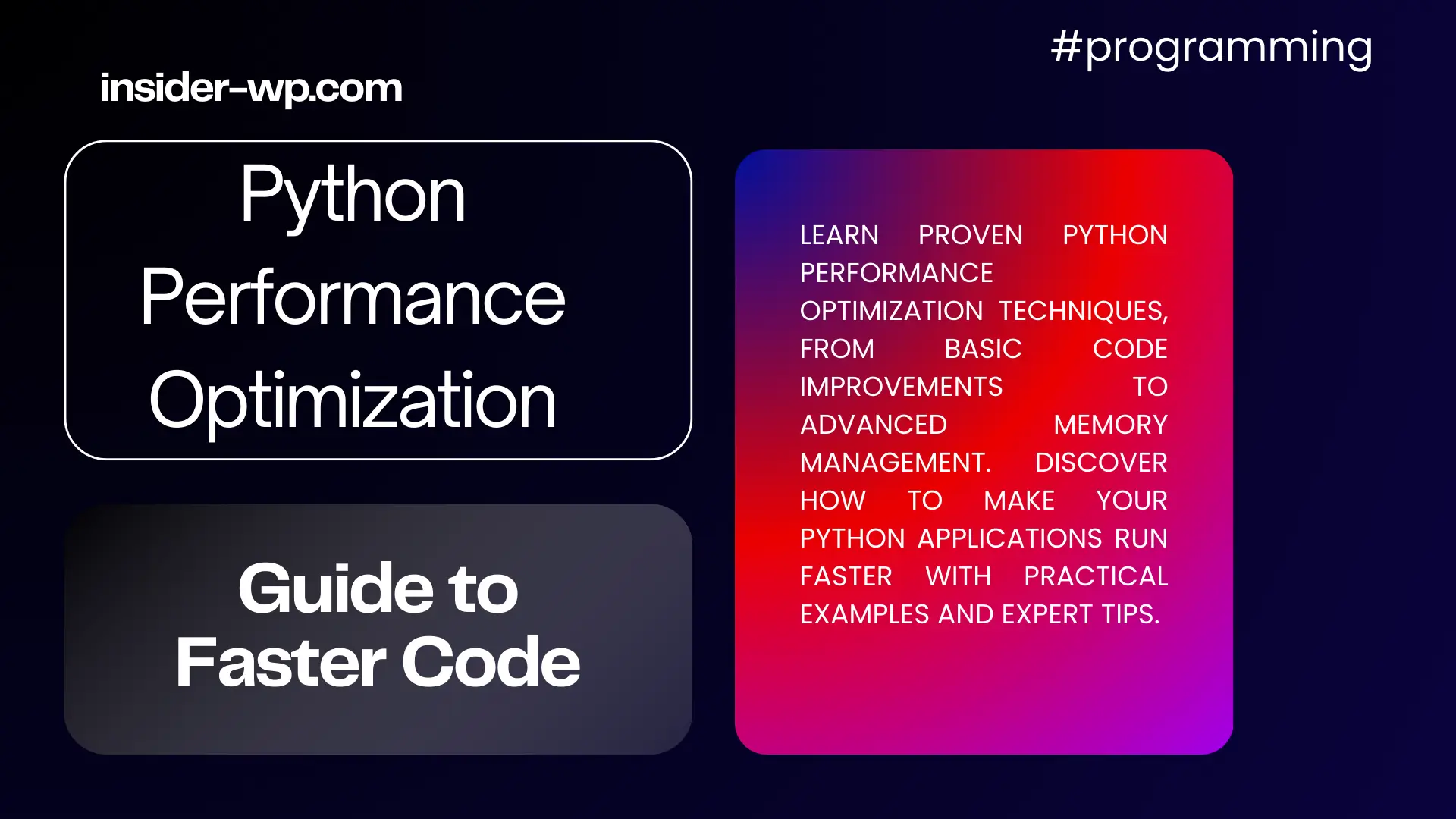Business Model vs Product Innovation: Which Drives More Growth

In today’s rapidly evolving business landscape, organizations face a crucial decision: should they focus on revolutionizing their business model or innovating their products? According to Harvard Business Review, companies that master both business model and product innovation are 30% more likely to achieve sustained growth compared to those focusing on just one approach.
Understanding the Fundamentals
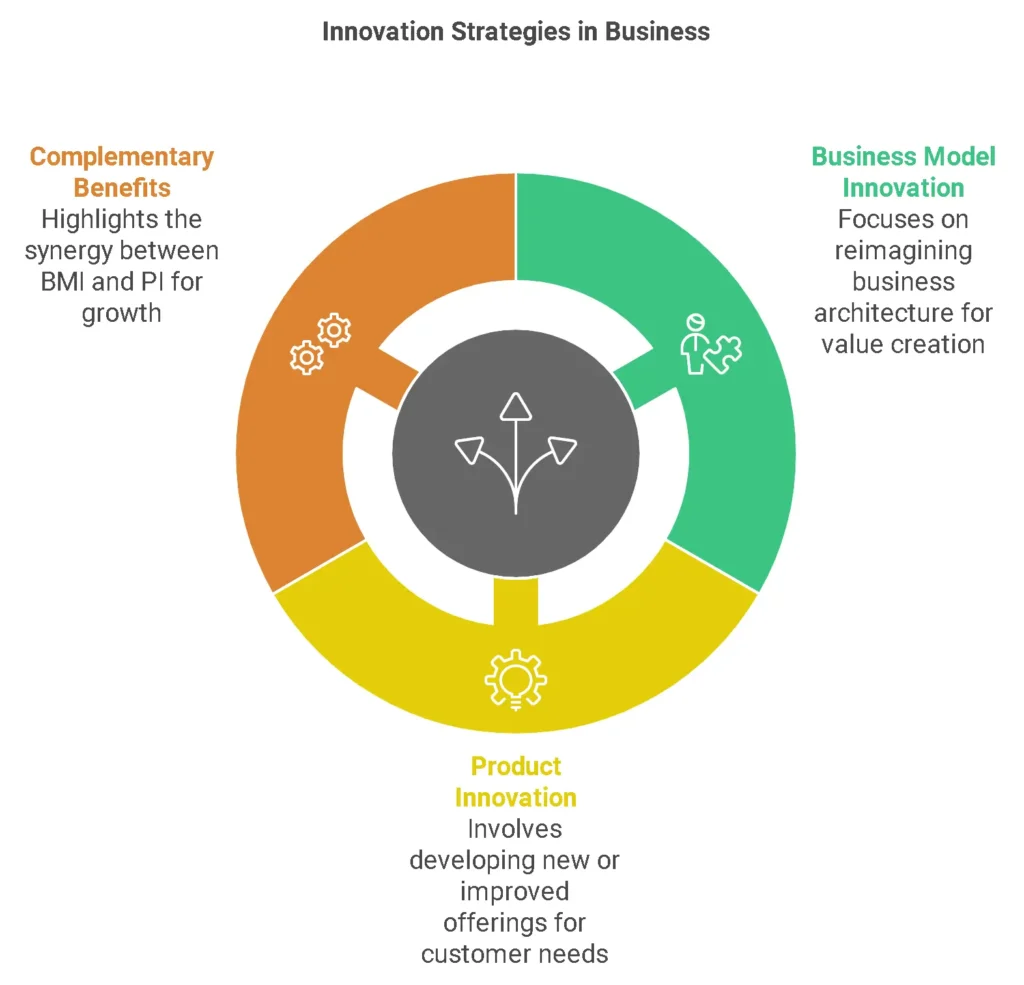
What is Business Model Innovation (BMI)?
Business Model Innovation (BMI) represents a fundamental shift in how organizations create, deliver, and capture value. Unlike traditional strategic changes, BMI involves reimagining the entire business architecture to discover new revenue streams and market opportunities.
- Value Proposition Redesign
- Revenue Model Transformation
- Operational Structure Changes
- Customer Relationship Evolution
According to research by McKinsey & Company, companies that successfully implement BMI achieve profit margins 6% higher than those who focus solely on product innovation.
What is Product Innovation (PI)?
Product Innovation focuses on developing new or improved offerings that better serve customer needs. It encompasses everything from incremental improvements to breakthrough innovations that create entirely new categories.
| Aspect | Product Innovation | Business Model Innovation |
|---|---|---|
| Primary Focus | Creating new/improved products | Reimagining value delivery |
| Time to Market | Generally shorter | Usually longer |
| Risk Level | Moderate | High |
| Investment Required | Variable | Often substantial |
Key Differences: Business Model Vs Product Innovation
The distinction between these two innovation types lies in their fundamental approach to value creation. While product innovation focuses on improving what you sell, business model innovation transforms how you sell it.
Case Study: Netflix’s Evolution
- Product Innovation: Improved streaming quality, recommendation algorithms
- Business Model Innovation: Shift from DVD rental to subscription-based streaming
According to MIT Sloan Management Review, successful business model innovation can deliver up to 4 times the return compared to product innovation alone.
The Strategic Importance of Both Innovation Types
In today’s competitive landscape, organizations need to consider both innovation types as complementary rather than mutually exclusive. Research by Deloitte indicates that companies implementing both BMI and PI experience:
- 2.5x higher revenue growth
- 3x better customer retention
- 4x improved market adaptability
Innovation Success Metrics (2023)
- Business Model Innovation: 42% success rate
- Product Innovation: 54% success rate
- Combined Approach: 67% success rate
Deep Dive into Business Model Innovation
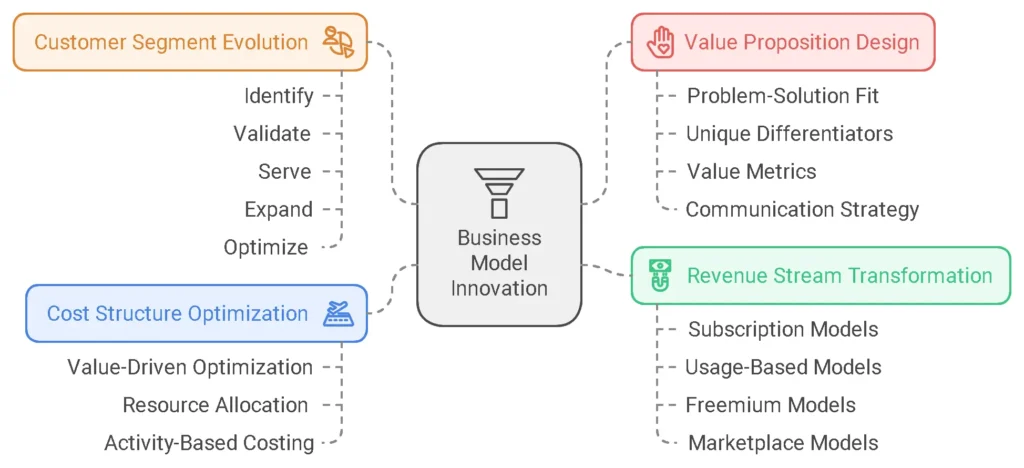
Let’s explore how business model innovation (BMI) can transform your organization’s approach to value creation and delivery. According to a Harvard Business Review study, companies that excel at BMI outperform their industry peers by up to 6% in total shareholder returns over three years.
Core Components of Business Model Innovation
Think of business model innovation as a puzzle with four essential pieces. Each component plays a crucial role in reshaping how your organisation creates and delivers value. Let’s break them down:
Value Proposition Design
Your value proposition is the heart of your business model innovation strategy. It’s not just about what you offer – it’s about why customers should care.
Key elements of effective value proposition design:
- Problem-Solution Fit: Clearly identify customer pain points and how your solution addresses them
- Unique Differentiators: What sets your offering apart from competitors
- Value Metrics: How customers measure the benefits they receive
- Communication Strategy: How you convey your value to different customer segments
The best value propositions create a clear connection between what your business does and why your customers need it.
McKinsey & Company
Revenue Stream Transformation
Innovative revenue models can dramatically improve your business’s financial performance. Here’s how successful companies approach revenue transformation:
| Revenue Model Type | Description | Example Companies |
| Subscription | Regular recurring revenue | Netflix, Spotify |
| Usage-Based | Pay per use/consumption | AWS, Uber |
| Freemium | Basic free + premium paid | Dropbox, LinkedIn |
| Marketplace | Platform connecting buyers/sellers | Airbnb, Amazon |
Cost Structure Optimization
Smart cost structure innovation isn’t just about cutting expenses – it’s about reimagining how you allocate resources for maximum impact.
Essential strategies include:
- Value-Driven Optimization
- Focus on activities that directly create customer value
- Eliminate or automate non-value-adding processes
- Invest in scalable technologies
- Resource Allocation
- Shift from fixed to variable costs where possible
- Leverage partnerships and outsourcing strategically
- Implement activity-based costing
Customer Segment Evolution
Your customer segments shouldn’t be static – they should evolve with market needs and opportunities.
📊 Customer Segment Evolution Framework:
Phase 1: Identify → Phase 2: Validate → Phase 3: Serve → Phase 4: Expand → Phase 5: Optimize
Types of Business Model Innovation
Business model innovation comes in several flavors, each with its own advantages and challenges:
- Disruptive Innovation
- Creates new markets
- Challenges industry incumbents
- Examples: Uber, Airbnb
- Architecture Innovation
- Reconfigures existing systems
- Leverages new technologies
- Examples: Amazon Web Services
- Efficiency Innovation
- Optimizes existing processes
- Reduces costs
- Examples: Southwest Airlines
- Experience Innovation
- Enhances customer interaction
- Creates emotional connections
- Examples: Apple, Disney
Risk Factors and Challenges in BMI
While business model innovation offers tremendous opportunities, it’s not without risks. Here are the key challenges to watch for:
🚧 Common BMI Challenges:
- Organizational Resistance
- Employee pushback
- Cultural barriers
- Legacy systems
- Market Uncertainty
- Customer adoption
- Competitive response
- Timing risks
- Resource Constraints
- Financial investment
- Talent requirements
- Technology needs
- Implementation Complexity
- Process changes
- System integration
- Partner alignment
Measuring BMI Success
To ensure your business model innovation efforts are paying off, you need a robust measurement framework:
Key Performance Indicators (KPIs) for BMI:
- Financial Metrics
- Revenue growth rate
- Customer lifetime value
- Cost-to-serve ratio
- Gross margin improvement
- Customer Metrics
- Customer acquisition cost
- Net promoter score
- Customer satisfaction
- Market share growth
- Operational Metrics
- Time-to-market
- Resource utilization
- Process efficiency
- Innovation adoption rate
- Strategic Metrics
- Competitive position
- Market penetration
- Brand strength
- Partnership value
💡 Pro Tip: Create a balanced scorecard that combines these metrics to get a holistic view of your BMI success.
Remember, successful business model innovation isn’t about making isolated changes – it’s about creating a cohesive system that delivers superior value to customers while capturing fair value for your organization. By understanding and carefully managing each component, you can dramatically increase your chances of success.
Read also: Business Model Innovation: Transform Your Business
Exploring Product Innovation Strategies

In today’s rapidly evolving market landscape, understanding product innovation strategies isn’t just beneficial—it’s essential for survival. Let’s dive into the frameworks and approaches that successful companies use to stay ahead of the curve.
The Product Innovation Framework
The foundation of successful product innovation lies in a well-structured framework that balances creativity with systematic execution. Here’s how industry leaders approach it:
Incremental vs Disruptive Innovation
Product innovation exists on a spectrum, with two primary approaches that serve different strategic purposes:
| Innovation Type | Characteristics | Risk Level | Example |
| Incremental | Small, continuous improvements to existing products | Lower | iPhone’s annual updates |
| Disruptive | Revolutionary changes that create new markets | Higher | Netflix’s streaming service |
According to a Harvard Business Review study, 70% of successful companies maintain a balanced portfolio of both incremental and disruptive innovations.
User-Centric Design Approaches
Modern product innovation revolves around the customer. Here’s how to implement a user-centric approach:
- Discovery Phase
- Conduct user research
- Create detailed personas
- Map customer journeys
- Identify pain points
- Design Phase
- Prototype development
- User testing
- Iterative refinement
- Feedback integration
The best products don’t just solve problems—they create experiences that customers didn’t know they needed.”
McKinsey & Company
Agile Development Methods
Agile methodology has revolutionized product innovation. Here’s a practical implementation framework:

Key Agile Principles for Product Innovation:
- Rapid iteration cycles
- Continuous customer feedback
- Cross-functional collaboration
- Flexible adaptation to change
Product Lifecycle Management
Effective product lifecycle management (PLM) is crucial for sustainable innovation. Here’s the comprehensive approach:
- Introduction Phase
- Market testing
- Initial feedback gathering
- Rapid iteration
- Growth Phase
- Scale production
- Market expansion
- Feature enhancement
- Maturity Phase
- Process optimisation
- Cost reduction
- Market defence
- Decline or Reinvention
- Product sunset planning
- Innovation opportunities
- Market repositioning
Technology Integration in PI
Modern product innovation relies heavily on technology integration. Here’s how to approach it:
Essential Technology Integration Elements:
✅ Cloud Computing
- Enables rapid scaling
- Facilitates global collaboration
- Reduces infrastructure costs
✅ AI and Machine Learning
- Predictive analytics for user behavior
- Automated testing and quality assurance
- Personalisation capabilities
✅ IoT Integration
- Real-time data collection
- Enhanced user experience
- Predictive maintenance
Common PI Pitfalls and Solutions
Let’s examine the most frequent challenges in product innovation and their solutions:
| Pitfall | Impact | Solution |
| Over-engineering | Resource waste, delayed launch | Implement MVP approach |
| Ignoring user feedback | Product-market misfit | Regular user testing sessions |
| Poor timing | Market opportunity loss | Thorough market analysis |
| Lack of focus | Scattered resources | Clear innovation roadmap |
Prevention Strategies:
- Regular Health Checks
- Weekly progress reviews
- Customer feedback analysis
- Market trend monitoring
- Resource allocation assessment
- Risk Mitigation
- Phased rollout strategy
- Backup plans for critical components
- Clear success metrics
- Regular stakeholder communication
The biggest risk in product innovation isn’t failure—it’s launching something nobody wants.
Product Innovation Institute
Remember: Successful product innovation isn’t about creating the most advanced technology—it’s about solving real customer problems in a way that’s both valuable and sustainable.
Pro Tip: When implementing these strategies, start with small, measurable experiments. Track your results and scale what works. This approach minimizes risk while maximizing learning opportunities.
Comparative Analysis: Business Model vs Product Innovation
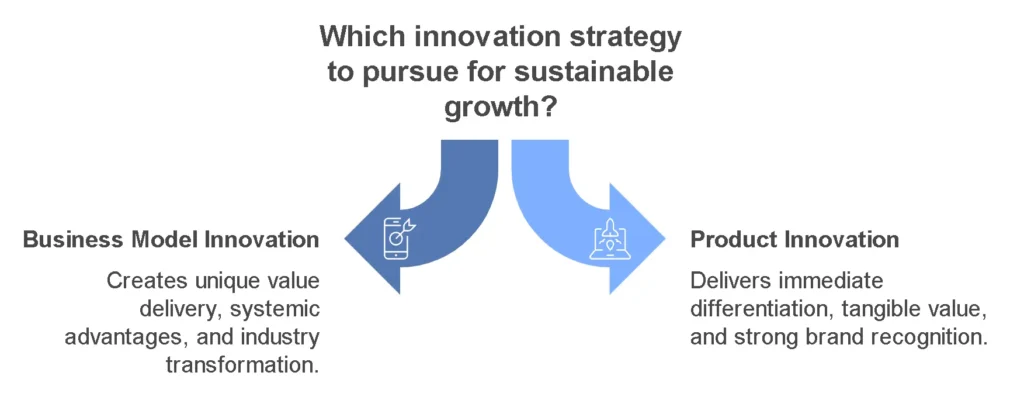
When it comes to driving business growth, understanding the fundamental differences between business model innovation (BMI) and product innovation (PI) is crucial. Let’s dive into a comprehensive comparison that will help you make informed strategic decisions for your organization.
Impact on Competitive Advantage
The battle between business model and product innovation in creating lasting competitive advantage is fascinating. Here’s why:
Business Model Innovation Advantages:
- Creates unique value delivery mechanisms that are harder for competitors to replicate
- Establishes systemic advantages through integrated business processes
- Often results in fundamental shifts that transform entire industries
Product Innovation Advantages:
- Delivers immediate market differentiation
- Creates tangible value propositions
- Builds strong brand recognition through innovative offerings
Consider this real-world example: While Apple’s iPhone was a brilliant product innovation, it was their iTunes + App Store business model innovation that created an unprecedented competitive moat. According to Harvard Business Review, business model innovations are 6x more likely to succeed over 15 years compared to product innovations.
Resource Requirements
Let’s break down the resource needs for both innovation types:
| Resource Type | Business Model Innovation | Product Innovation |
| Financial Investment | High upfront costs for systemic changes | Moderate to high, scalable with project scope |
| Human Capital | Cross-functional teams, leadership involvement | Specialized R&D teams |
| Time Investment | 12-24 months for full implementation | 3-12 months depending on complexity |
| Infrastructure | Significant organizational changes | Primarily technical resources |
| Risk Level | High (affects entire organization) | Moderate (contained to product line) |
Implementation Timeframes
Understanding the timeline differences is crucial for strategic planning:
Business Model Innovation Timeline:
- Strategy Development: 3-6 months
- Organizational Alignment: 2-4 months
- Systems Implementation: 6-12 months
- Market Testing: 3-6 months
- Full Deployment: 6-12 months
Product Innovation Timeline:
- Concept Development: 1-2 months
- Prototyping: 2-3 months
- Testing & Iteration: 2-4 months
- Production Setup: 1-3 months
- Market Launch: 1-2 months
💡 Pro Tip: While product innovation can show quicker results, business model innovation often provides more sustainable long-term advantages.
ROI Expectations
Let’s examine the return on investment patterns for both approaches:
Business Model Innovation ROI:
- Initial Period (0-12 months): Often negative returns due to implementation costs
- Medium Term (1-3 years): Gradual improvement in profitability
- Long Term (3+ years): Potential for exponential growth
- Average ROI: 204% over 5 years according to McKinsey & Company
Product Innovation ROI:
- Initial Period (0-6 months): Quick revenue generation from early adopters
- Medium Term (6-18 months): Peak performance period
- Long Term (18+ months): Declining returns unless continuously updated
- Average ROI: 85% over 2 years
Read also : Calculate ROI: Guide for Any Investment
Market Disruption Potential
Understanding the disruptive impact of each innovation type is crucial for strategic planning:
Business Model Innovation Disruption:
- Creates new markets or industry categories
- Fundamentally changes how value is delivered
- Examples: Netflix (streaming), Amazon (AWS), Uber (ride-sharing)
Product Innovation Disruption:
- Improves existing markets
- Enhances customer experience
- Examples: Electric vehicles, smartphones, smart home devices
Consider this disruption potential matrix:
| Aspect | Business Model Innovation | Product Innovation |
| Market Impact | Industry-wide transformation | Market segment evolution |
| Competition Response Time | Slower (12-24 months) | Faster (3-6 months) |
| Entry Barriers | Creates new barriers | Works within existing barriers |
| Sustainability | High (5-10 years) | Medium (2-5 years) |
| First-mover Advantage | Very strong | Moderate to strong |
🔑 Key Insight: While product innovation can create immediate market impact, business model innovation often leads to more sustainable competitive advantages and industry-wide transformation.
Real-World Success Metrics:
- Business Model Innovation: Spotify achieved 456% revenue growth over 5 years through their streaming model
- Product Innovation: Tesla’s Model 3 captured 23% of the electric vehicle market within 2 years
Making the Strategic Choice
When deciding between business model and product innovation, consider these factors:
- Your organization’s risk tolerance
- Available resources and timeframes
- Current market position
- Industry dynamics
- Competitive landscape
Remember, the most successful companies often implement a hybrid approach, using both types of innovation strategically to maintain competitive advantage while driving growth.
Interesting fact: According to the Boston Consulting Group, companies that excel at both business model and product innovation outperform their peers by an average of 30% in long-term shareholder value creation.]
This comparative analysis demonstrates that while both innovation types have their merits, the choice between them—or the decision to pursue both—should align with your organization’s strategic objectives, resources, and market position.
Integration Strategies: Combining Business Model and Product Innovation for Maximum Impact
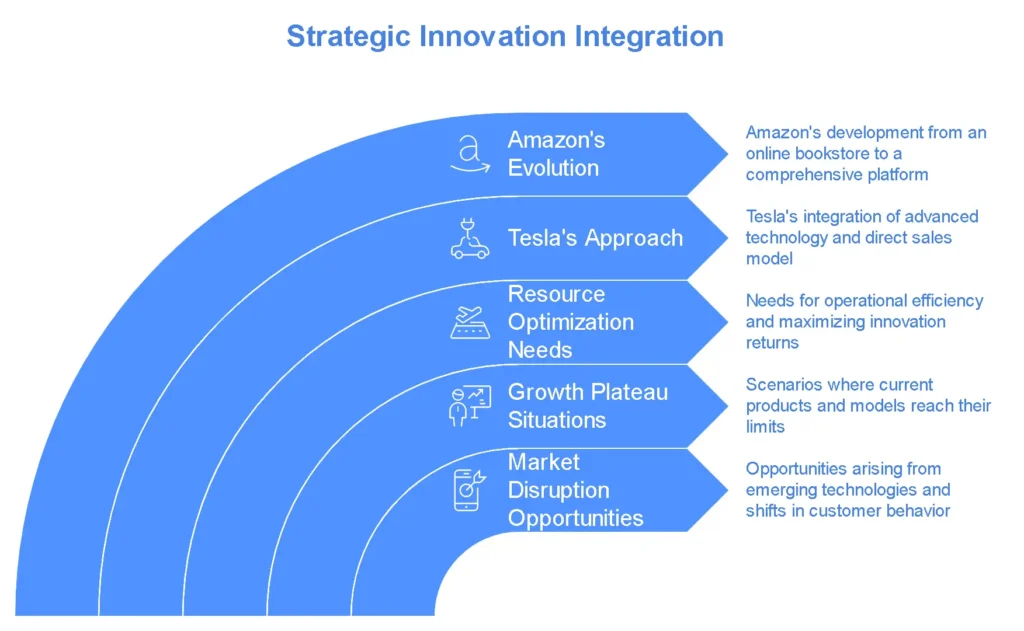
In today’s rapidly evolving market, the distinction between business model innovation (BMI) and product innovation (PI) is becoming increasingly blurred. According to research by McKinsey [https://www.mckinsey.com/business-functions/strategy-and-corporate-finance/our-insights/innovation-in-a-crisis-why-it-is-more-critical-than-ever], organisations that successfully integrate both approaches are 30% more likely to achieve breakthrough growth.
When to Combine BMI and PI
The decision to integrate business model and product innovation should be strategic rather than arbitrary. Here are key scenarios when combining both approaches makes sense:
- Market Disruption Opportunities
- When emerging technologies create new possibilities
- During significant shifts in customer behavior
- When facing new competitive threats
- Growth Plateau Situations
- When current products have maximized market potential
- If existing business models show diminishing returns
- During industry-wide transformation phases
- Resource Optimisation Needs
- When seeking operational efficiencies
- During digital transformation initiatives
- For maximizing return on innovation investment
🔑 Key Insight: The most successful integrations occur when organizations identify complementary aspects of both innovation types that can create multiplicative rather than additive value.
Creating Synergies Between Models
To create effective synergies between business model and product innovation, consider this framework:
The Innovation Integration Matrix:
| BMI Component | PI Element | Potential Synergy |
| Value Proposition | Product Features | Enhanced customer value delivery |
| Revenue Streams | Product Pricing | Innovative monetisation models |
| Customer Segments | User Experience | Targeted solution development |
| Cost Structure | Production Process | Optimized resource allocation |
Steps for Successful Integration:
- Align Innovation Objectives
- Define clear goals for both BMI and PI initiatives
- Identify overlap points and potential conflicts
- Create unified success metrics
- Build Cross-functional Teams
- Combine business strategists with product developers
- Integrate customer insights across both domains
- Foster collaborative innovation culture
- Implement Iterative Processes
- Use agile methodologies for both business and product development
- Create feedback loops between BMI and PI teams
- Regular evaluation and adjustment of integration strategies
Case Studies of Successful Integration
Tesla’s Approach: Revolutionising Both Product and Business Model
Tesla exemplifies the perfect marriage of business model and product innovation. Their approach includes:
- Product Innovation:
- Advanced electric vehicle technology
- Continuous software updates
- Battery technology breakthroughs
- Business Model Innovation:
- Direct-to-consumer sales model
- Supercharger network ecosystem
- Energy storage solutions
🎯 Success Metric: Tesla’s integrated approach led to a 743% revenue growth over five years, according to Harvard Business Review [https://hbr.org/2021/tesla-innovation-strategy].
Amazon’s Evolution: From Books to Everything Store
Amazon’s journey showcases how BMI and PI can evolve together:
Key Integration Points:
- AWS development (PI) enabling new business models
- Prime membership (BMI) driving product development
- Marketplace platform (BMI) influencing fulfillment innovation (PI)
Visual representation of Amazon’s Innovation Integration:
Innovation Timeline:
- 1995: Online bookstore
- 2005: Prime membership + Fulfillment innovation
- 2006: AWS launch
- 2014: Echo & Alexa
- 2017: Whole Foods acquisition
Apple’s Strategy: Ecosystem Innovation
Apple’s integration of BMI and PI created one of the world’s most valuable companies through:
- Hardware Innovation (PI)
- Revolutionary product design
- Cutting-edge technology integration
- Premium quality standards
- Services Evolution (BMI)
- App Store ecosystem
- Subscription services (Apple One)
- Financial services integration
- Combined Impact
- Seamless customer experience
- High switching costs
- Multiple revenue streams
💡 Pro Tip: The success of these case studies highlights the importance of viewing innovation holistically rather than as separate initiatives.
Best Practices from Case Studies:
- Start with customer needs
- Build scalable foundations
- Maintain flexibility in both business model and product development
- Create self-reinforcing innovation loops
- Focus on long-term value creation
The most powerful innovations come from the synchronization of business model transformation and product development.
Clayton Christensen, Harvard Business School
By examining these successful integrations, we can see that the most impactful innovations often occur when organizations strategically combine business model and product innovation. The key is not just to implement both types of innovation but to create meaningful connections between them that drive sustainable competitive advantage.
This strategic integration approach has become increasingly crucial in today’s fast-paced market environment, where standalone innovations – whether in business models or products – may not be sufficient to maintain competitive advantage.
Industry-Specific Considerations
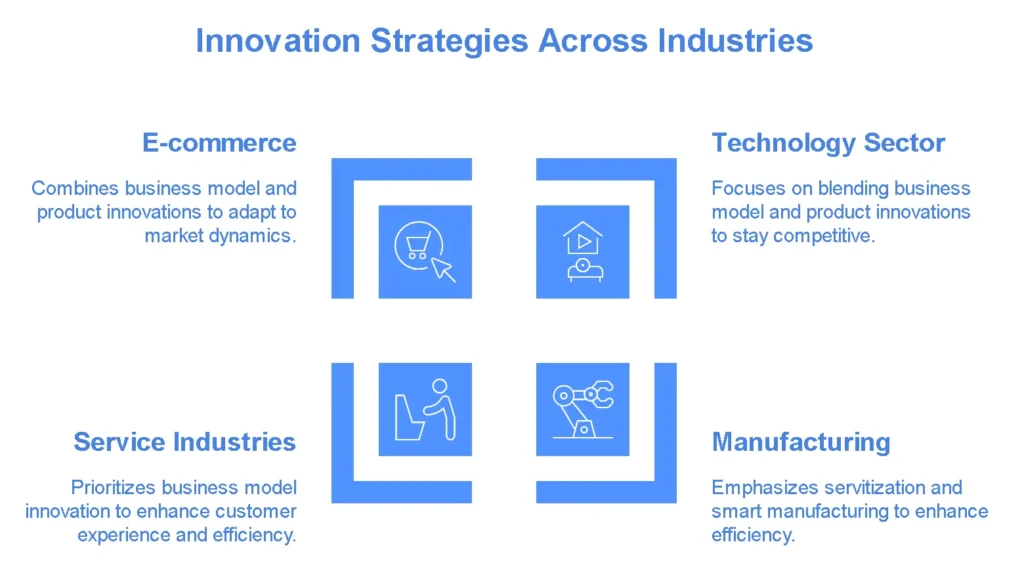
The choice between business model innovation and product innovation varies significantly across industries. Let’s explore how different sectors approach these innovation strategies and what drives their decisions.
Technology Sector
The technology sector stands at the forefront of both business model and product innovation, often blending the two approaches for maximum impact. Companies in this space face unique challenges and opportunities:
Key Characteristics:
- Rapid market changes
- Short product lifecycles
- High R&D investments
- Strong competitive pressures
According to a McKinsey study, 78% of successful tech companies combine both innovation approaches. Here’s how they typically implement each:
Business Model Innovation in Tech:
- Subscription-based services (SaaS)
- Platform-as-a-Service (PaaS)
- Marketplace models
- Freemium strategies
Product Innovation in Tech:
- AI/ML integration
- Cloud-native solutions
- Edge computing
- User experience enhancements
Manufacturing
The manufacturing sector traditionally focused on product innovation, but Industry 4.0 has sparked a revolution in business model thinking. Here’s how manufacturers are adapting:
Traditional Approach:
| Innovation Type | Common Applications |
| Product | – New materials – Enhanced features – Improved durability |
| Business Model | – Product-as-a-Service – Predictive maintenance – Digital twin solutions |
Key Trends:
- Shift towards servitisation
- Integration of IoT and smart manufacturing
- Sustainability-driven innovations
- Supply chain optimization
According to Deloitte’s Manufacturing Innovation Study, manufacturers who adopted both BMI and PI saw a 32% higher revenue growth compared to those focusing on just one approach.
Service Industries
Service industries present a unique case where business model innovation often takes precedence over product innovation. However, the rise of digital services has blurred these lines.
Key Focus Areas:
- Customer Experience Enhancement
- Personalization
- Omnichannel delivery
- Self-service options
- Operational Efficiency
- Process automation
- Digital transformation
- Resource optimisation
- Value Creation Models
- Outcome-based pricing
- Subscription services
- Hybrid delivery models
Innovation Distribution in Service Industries:
- Business Model Innovation: 60%
- Product Innovation: 25%
- Hybrid Approaches: 15%
E-commerce
E-commerce represents perhaps the most dynamic sector for innovation, where business models and products constantly evolve and intersect.
Current Innovation Landscape:

Notable Trends:
- Integration of AR/VR for product visualization
- AI-driven personalisation
- Social commerce integration
- Sustainable e-commerce practices
Research from Harvard Business Review suggests that successful e-commerce businesses spend:
- 40% of innovation budget on business model innovation
- 35% on product innovation
- 25% on hybrid approaches
Key Success Factors:
- Customer-Centric Focus
- Understanding user behavior
- Addressing pain points
- Enhancing user experience
- Technology Integration
- Mobile-first approach
- AI/ML implementation
- Security enhancements
- Market Adaptability
- Quick pivot capabilities
- Scalable solutions
- Flexible infrastructure
Best Practices Across Industries:
- Regular innovation audits
- Customer feedback integration
- Cross-functional collaboration
- Agile methodology adoption
- Data-driven decision making
Each industry requires a tailored approach to innovation, considering:
- Market maturity
- Competition intensity
- Customer expectations
- Regulatory environment
- Technology readiness
- Resource availability
Remember, successful innovation isn’t about choosing between business model and product innovation—it’s about finding the right balance for your specific industry context and organizational capabilities.
Implementation Framework: A Strategic Approach to Innovation

When it comes to implementing either business model or product innovation, success lies in the execution. Let’s dive into a comprehensive framework that’ll help you navigate this complex journey.
Assessment and Strategy Selection
Before diving headfirst into innovation, you’ll need a rock-solid assessment strategy. Here’s how to approach it:
- Current State Analysis
- Conduct a SWOT analysis of your existing business model or product portfolio
- Assess market position and competitive landscape
- Review current performance metrics (Harvard Business Review)
- Evaluate organizational readiness for change
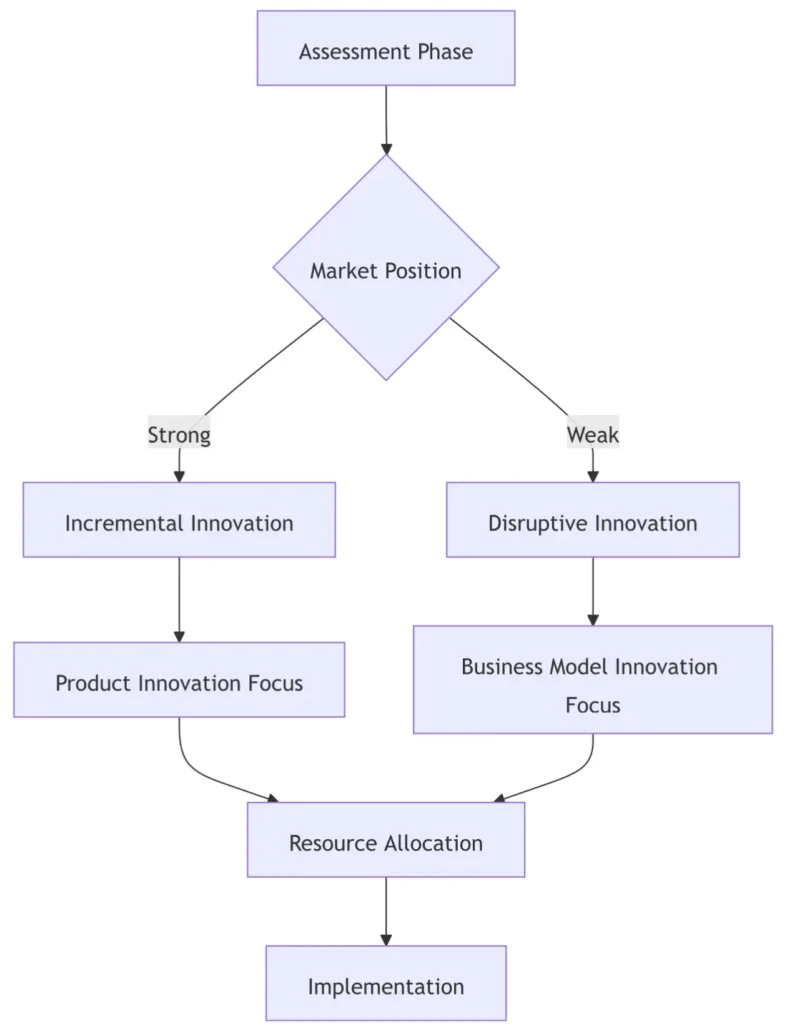
Strategy Selection Framework:
| Innovation Type | Market Conditions | Resource Requirements | Time to Market | Risk Level |
| Business Model | Disrupted markets | High | 12-24 months | High |
| Product | Stable markets | Medium | 6-12 months | Medium |
| Hybrid | Mixed conditions | Very High | 18-36 months | Very High |
Resource Allocation
Proper resource allocation can make or break your innovation initiative. Here’s your comprehensive resource planning guide:
Financial Resources:
- Innovation budget allocation (typically 15-25% of operational budget)
- Investment in technology and tools
- Training and development funds
- Buffer for unexpected expenses
Human Capital:
- Core Innovation Team
- Innovation lead/champion
- Project managers
- Technical experts
- Design thinking specialists
- Support Functions
- IT support
- Change management specialists
- Training facilitators
- External consultants (when needed)
Pro Tip: According to McKinsey’s research, successful innovators allocate resources more dynamically, with quarterly reviews and adjustments based on performance metrics.
Change Management
Let’s face it – innovation means change, and change can be tricky. Here’s your blueprint for managing the transition:
- Communication Strategy
- Regular stakeholder updates
- Clear messaging about the why, what, and how
- Multiple communication channels
- Two-way feedback mechanisms
- Resistance Management Plan
- Step 1: Identify potential sources of resistance
- Step 2: Develop targeted mitigation strategies
- Step 3: Create support systems
- Step 4: Monitor and adjust the approach
- Training and Development
- Skills gap analysis
- Custom training programs
- Mentoring systems
- Knowledge sharing platforms
Performance Monitoring
You can’t improve what you don’t measure. Here’s how to track your innovation success:
Key Performance Indicators (KPIs):
| Metric Category | Business Model Innovation | Product Innovation |
| Financial | – Revenue growth rate – Profit margin improvement – Customer lifetime value | – Sales growth – Market share – ROI on product |
| Customer | – Customer satisfaction scores – Net Promoter Score – Customer retention rate | – Product adoption rate – User engagement – Feature usage |
| Operational | – Process efficiency gains – Cost reduction – Employee productivity | – Time to market – Development cycle time – Defect rate |
| Innovation | – Number of new revenue streams – Business model iterations – Partner ecosystem growth | – Number of new products – Patent applications – Innovation pipeline health |
Monitoring Best Practices:
- Regular Review Cycles
- Weekly: Operational metrics
- Monthly: Performance metrics
- Quarterly: Strategic metrics
- Annually: Overall innovation impact
- Adaptive Framework
- Set clear baselines
- Establish realistic targets
- Create feedback loops
- Adjust metrics as needed
Pro Tip: The most successful organizations use data visualization tools to track these metrics in real-time dashboards, making it easier to spot trends and make quick decisions.
Implementation Checklist:
- Conduct a thorough initial assessment
- Select the appropriate innovation strategy
- Allocate resources effectively
- Develop a change management plan
- Set up monitoring systems
- Create feedback mechanisms
- Schedule regular reviews
- Plan for contingencies
Remember, implementing innovation isn’t a one-size-fits-all process. Whether you’re focusing on business model innovation, product innovation, or both, the key is to remain flexible and adaptive while maintaining a structured approach to implementation.
By following this framework, you’ll be better positioned to navigate the complexities of innovation implementation while maintaining focus on your strategic objectives. Remember to regularly review and adjust your approach based on performance metrics and changing market conditions.
Future Trends and Predictions: The Evolution of Business Model and Product Innovation
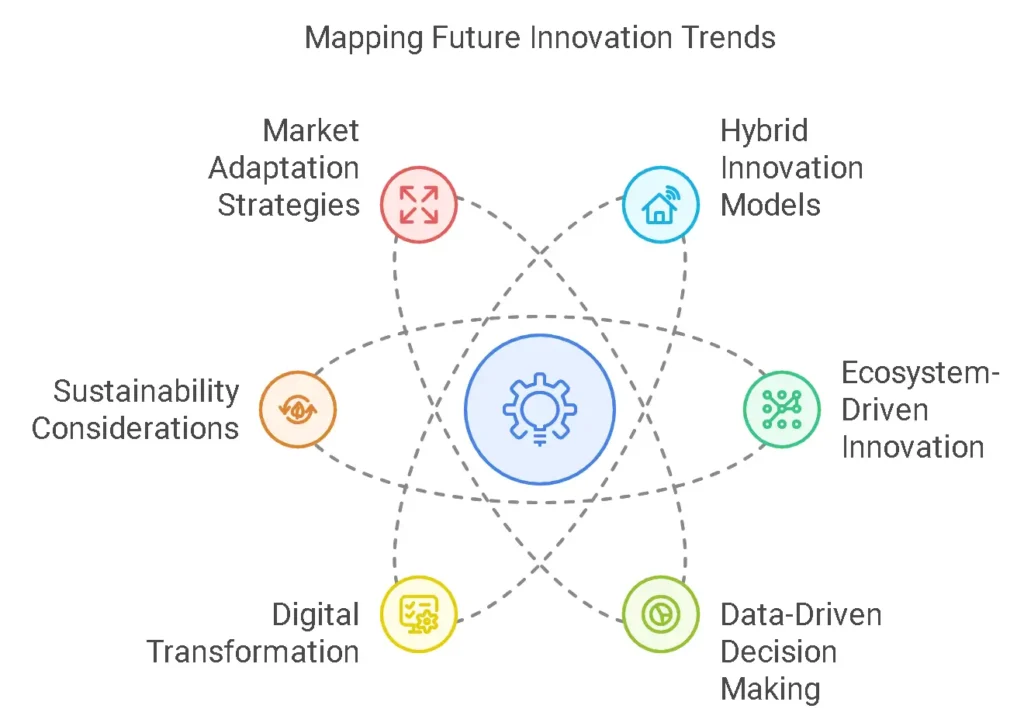
The landscape of innovation is rapidly evolving, shaped by technological advancements, changing consumer behaviors, and global market dynamics. Let’s explore how these changes are influencing both business models and product innovation strategies.
Emerging Innovation Patterns
The way organizations approach innovation is undergoing a fundamental shift. Here are the key patterns emerging:
- Hybrid Innovation Models
- Combination of business model and product innovation becoming increasingly common
- Integration of physical and digital offerings (phygital experiences)
- Cross-industry innovation adoption rising by 47% annually Source: McKinsey & Company
- Ecosystem-Driven Innovation : Emerging Ecosystem Trends
- Collaborative: 68% adoption
- Platform-based: 52% adoption
- Network-driven: 43% adoption
- Data-Driven Decision Making
- AI-powered innovation strategies
- Predictive analytics for market testing
- Real-time customer feedback loops
Digital Transformation Impact
Digital transformation is revolutionizing both business model and product innovation approaches:
Key Digital Drivers:
- Artificial Intelligence Integration
- Automated innovation processes
- Smart product development
- Personalized customer experiences
- Internet of Things (IoT) Evolution
- Connected product ecosystems
- Service-based revenue models
- Real-time performance monitoring
By 2025, 75% of business leaders will leverage digital platforms to adapt to new markets and industries, with 80% of organizations adopting hybrid business models.
Gartner Research
Transformation Priority Matrix:
| Priority Area | Business Model Impact | Product Innovation Impact |
| Cloud Computing | High – New delivery models | Medium – Development efficiency |
| AI/ML | Very High – Automated systems | High – Smart products |
| Blockchain | Medium – Trust systems | Low – Product features |
| 5G | High – Service delivery | Very High – Product capabilities |
Sustainability Considerations
Sustainability is becoming a crucial driver of innovation:
- Circular Economy Models
- Product-as-a-service offerings increasing by 40% annually
- Refurbishment and recycling integration
- Shared resource utilization
- Green Innovation Practices
- Eco-friendly product development
- Sustainable supply chain integration
- Carbon-neutral business operations
- Social Impact Integration: Sustainable Innovation Priorities:
- Environmental Impact (42%)
- Social Responsibility (28%)
- Economic Viability (18%)
- Governance (12%)
Market Adaptation Strategies
Organizations must develop robust adaptation strategies to thrive in this evolving landscape:
Core Adaptation Components:
- Agile Innovation Framework
- Rapid prototyping and testing
- Flexible business model pivots
- Iterative product development
- Customer-Centric Evolution
- Real-time feedback integration
- Personalisation at scale
- Experience-driven innovation
- Risk Management Innovation
- Scenario planning integration
- Diversified innovation portfolios
- Resilient business models
Companies that successfully balance adaptation and innovation are 3x more likely to outperform their competitors in long-term growth.
Boston Consulting Group
Strategic Implementation Guidelines:
- Short-term Adaptation (0-12 months)
- Market monitoring systems
- Rapid response protocols
- Flexible resource allocation
- Medium-term Evolution (1-3 years)
- Business model experimentation
- Product portfolio diversification
- Technology infrastructure updates
- Long-term Transformation (3-5 years)
- Ecosystem development
- Sustainable innovation integration
- Cultural transformation
🔑 Key Takeaway: The future of innovation lies in the ability to seamlessly integrate business model and product innovation while adapting to digital transformation, sustainability requirements, and changing market dynamics. Successful organizations will be those that can maintain agility while building robust, sustainable innovation capabilities.
As we move forward, the distinction between business model and product innovation will continue to blur, creating opportunities for:
- Integrated innovation approaches
- Sustainable growth models
- Enhanced customer value creation
- Ecosystem-based collaboration
- Technology-enabled transformation
This evolution requires organizations to develop comprehensive innovation strategies that consider both immediate market needs and long-term sustainability goals while maintaining the flexibility to adapt to emerging trends and opportunities.
Success Stories and Case Studies
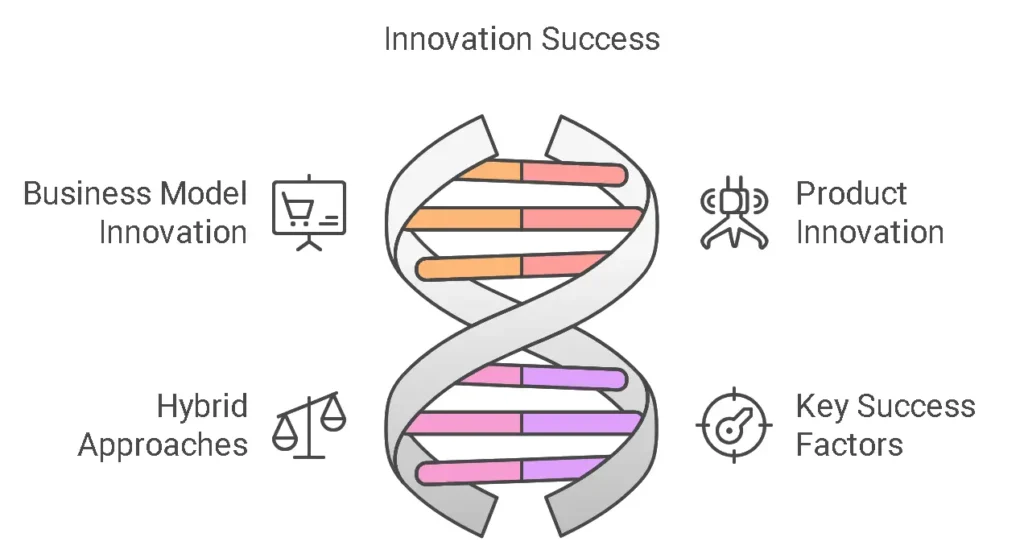
Let’s explore some remarkable examples of companies that have mastered different innovation approaches, transforming their industries and achieving extraordinary results through business model innovation, product innovation, or a hybrid approach.
Business Model Innovation Examples
Netflix: From DVD Rental to Streaming Giant
- Original Model: DVD-by-mail rental service
- Innovation: Subscription-based streaming platform
- Impact:
- Market value increased from $2B (2010) to $150B+ (2024)
- 247.15 million paid subscribers globally
- Created an entirely new entertainment consumption model
Spotify: Revolutionising Music Consumption
- Innovation: Freemium model in music streaming
- Key Changes:
- Introduced ad-supported free tier
- Premium subscription for ad-free experience
- Revenue sharing with artists
- Results:
- 489 million active users
- Transformed music industry revenue model
- Created sustainable streaming economy
Business model innovation isn’t just about changing how you sell – it’s about reimagining how you create and capture value.
Harvard Business Review 🔗
Product Innovation Success Stories
Apple iPhone: Redefining Mobile Technology
- Innovation Timeline:
| Year | Innovation | Impact |
| 2007 | Original iPhone | Revolutionised smartphone industry |
| 2010 | FaceTime | Changed video communication |
| 2013 | Touch ID | Mainstreamed biometric security |
| 2017 | Face ID | Advanced facial recognition standard |
- Results:
- 2.2 billion iPhones sold worldwide
- Created $3 trillion market value
- Established new product category
Tesla: Electric Vehicle Revolution
- Key Innovations:
- Long-range electric vehicles
- Over-the-air software updates
- Advanced autopilot capabilities
- Impact:
- Forced traditional automakers to accelerate EV development
- Created new standards for electric vehicle performance
- Achieved 1.8 million vehicle deliveries in 2023
Hybrid Approach Winners
Amazon: Mastering Both Worlds
Business Model Innovations:
- Prime membership
- AWS cloud services
- Marketplace platform
Product Innovations:
- Kindle e-readers
- Echo smart speakers
- Amazon Go stores
Combined Impact:
- 200+ million Prime members
- AWS generates $80+ billion annual revenue
- Revolutionary shopping experience
Microsoft: Traditional Product Company to Innovation Leader
Strategic Evolution:
| Innovation Type | Example | Impact |
| Product | Windows 11 | 1.4B+ active devices |
| Business Model | Microsoft 365 | 345M+ paid subscriptions |
| Hybrid | Azure Cloud + AI | $28B quarterly revenue |
Adobe: Creative Suite to Creative Cloud
Transformation Highlights:
- Shifted from packaged software to subscription model
- Introduced cloud-based collaboration tools
- Continuous product innovation through AI integration
- Results:
- Revenue grew from $4B (2013) to $17B+ (2023)
- 29 million+ creative cloud subscribers
- Enhanced customer lifetime value
The most successful companies don’t just innovate their products – they innovate their entire business system.
MIT Sloan Management Review 🔗
Key Success Factors Across All Examples
📊 Common Patterns for Success:
- Customer-centric approach
- Clear value proposition
- Timing market entry correctly
- Strong execution capabilities
- Continuous iteration and improvement
Learning Points for Businesses:
- Innovation success requires both courage and careful planning
- Market timing is crucial for both BMI and PI
- Customer feedback should drive innovation decisions
- Technology enables but doesn’t guarantee success
- Hybrid approaches often yield the best results
Studying these success stories reveals that while some companies excel through focused innovation in either business models or products, the most sustainable growth often comes from a balanced approach that combines both strategies effectively.
Pro Tip: When analyzing these cases for your own business, focus not just on what these companies did, but on why their innovations succeeded in their specific market contexts.
This analysis shows that successful innovation, whether in business models, products, or both, requires:
- Deep understanding of customer needs
- Willingness to take calculated risks
- Strong execution capabilities
- Continuous adaptation and improvement
- Clear vision and strategic alignment
The next section will explore practical tips and best practices for implementing these lessons in your own organization’s innovation journey.
Practical Tips and Best Practices
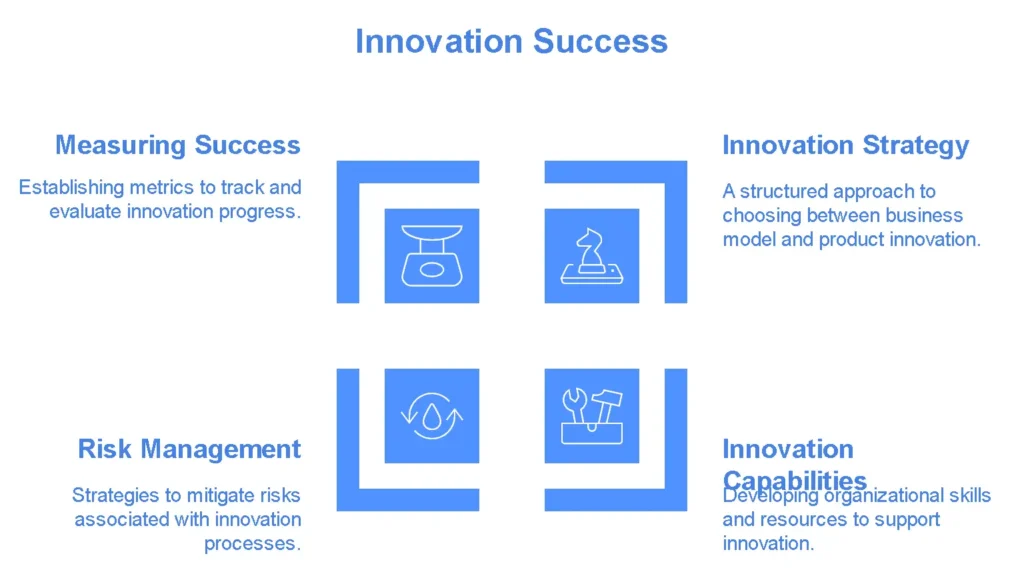
Making the leap into innovation, whether through business model transformation or product development, requires a structured approach backed by proven strategies. Let’s explore practical guidelines that can help your organization navigate this complex landscape successfully.
Choosing the Right Innovation Approach
Selecting between business model innovation (BMI) and product innovation (PI) isn’t a one-size-fits-all decision. Here’s a comprehensive decision framework to guide your choice:
Assessment Matrix for Innovation Strategy Selection:
| Criteria | Consider BMI When | Consider PI When |
| Market Position | Declining market share in current model | Strong market position but product fatigue |
| Competition | New entrants disrupting industry norms | Direct competitors launching superior products |
| Resources | Significant organizational flexibility | Strong R&D capabilities |
| Time Horizon | Long-term strategic transformation | Shorter time-to-market requirements |
| Customer Feedback | Dissatisfaction with business model | Product feature requests |
🔑 Key Consideration Factors:
- Market Analysis
- Current market position
- Competitive landscape
- Industry disruption potential
- Internal Capabilities
- Available resources
- Technical expertise
- Organizational flexibility
- Strategic Objectives
- Growth targets
- Risk tolerance
- Timeline requirements
Pro Tip: According to research by McKinsey & Company, companies that successfully combine both BMI and PI achieve 50% higher revenue growth compared to those focusing on just one type.
Building Innovation Capabilities
Creating a robust innovation framework requires developing specific capabilities within your organization. Here’s how to build a strong foundation:
- Cultural Development
- Foster an experimentation mindset
- Encourage calculated risk-taking
- Implement reward systems for innovation
- Skill Enhancement: Priority Areas:
- Design thinking
- Agile methodologies
- Data analytics
- Customer insight gathering
- Change management
- Resource Allocation
- Dedicated innovation teams
- Innovation labs or incubators
- Training and development programs
- Technology infrastructure
🎯 Action Steps for Capability Building:
- Assess current capabilities
- Identify capability gaps
- Develop learning roadmap
- Implement training programs
- Monitor and adjust
Risk Management Strategies
Innovation inherently carries risks, but these can be managed through proper planning and execution:
Risk Mitigation Framework
- Strategic Risks
- Market timeing
- Competition response
- Resource allocation
- Operational Risks
- Implementation challenges
- Technical feasibility
- Team capabilities
- Financial Risks
- Investment requirements
- ROI uncertainty
- Cash flow impact
Expert Insight: According to Harvard Business Review, successful innovators are 2.7 times more likely to have robust risk management processes in place.
Risk Management Best Practices
- Start with pilot programs
- Use stage-gate processes
- Implement regular review cycles
- Maintain contingency plans
- Monitor key risk indicators
Measuring Innovation Success
Establishing clear metrics is crucial for tracking innovation progress and success:
Key Performance Indicators (KPIs):
- Financial Metrics
- Revenue growth
- Profit margins
- Market share
- Return on innovation investment
- Customer Metrics
- Customer satisfaction scores
- Adoption rates
- Net Promoter Score (NPS)
- Customer lifetime value
- Process Metrics
- Time to market
- Innovation pipeline health
- Success rate of initiatives
- Employee engagement in innovation
📊 Innovation Measurement Dashboard Example:
Monthly Innovation Metrics:
✓ New revenue from innovations: XX%
✓ Customer satisfaction increase: XX%
✓ Implementation efficiency: XX%
✓ Innovation ROI: XX%
✓ Team engagement score: XX%
Success Tracking Framework:
- Set clear baseline metrics
- Define success criteria
- Implement regular measurement cycles
- Adjust strategies based on data
- Celebrate and communicate wins
💡 Pro Tip: According to Boston Consulting Group, top innovators are 30% more likely to use quantitative metrics to track innovation performance.
Remember, successful innovation requires a balanced approach between ambition and pragmatism. Start with clear objectives, build necessary capabilities, manage risks effectively, and measure progress consistently.
Additional Resources:
By following these practical guidelines and best practices, organizations can significantly improve their chances of success in both business model and product innovation initiatives. The key is to remain flexible and adapt these frameworks to your specific context while maintaining a consistent focus on value creation and risk management.
Conclusion: Making the Right Choice
After diving deep into the realms of business model innovation (BMI) and product innovation (PI), it’s clear that both approaches offer unique pathways to organizational growth and market leadership. Let’s distill the essential insights and provide a practical framework for making an informed choice.
Summary of Key Points
Here’s what we’ve learned about the Business Model vs Product Innovation debate:
- Strategic Impact
- Business Model Innovation focuses on fundamental value creation and capture mechanisms
- Product Innovation drives market competitiveness through new offerings
- Both can create sustainable competitive advantages when executed properly
- Resource Implications
- BMI typically requires broader organizational changes
- PI often needs dedicated R&D resources
- Both benefit from cross-functional collaboration
- Risk Profile
- BMI carries higher organizational risks but potentially greater rewards
- PI involves more predictable market risks
- Both require careful change management
Decision Framework
To help you choose between business model and product innovation—or determine how to combine them—consider this decision matrix:
| Consideration Factor | Choose Business Model Innovation If… | Choose Product Innovation If… |
| Market Position | Your industry faces disruption | You have strong market share |
| Resources | You can sustain long-term change | You have strong R&D capabilities |
| Competition | Traditional approaches are failing | Product features drive purchases |
| Customer Needs | Value proposition needs updating | Specific pain points exist |
| Timeline | You can invest in long-term change | Quick wins are needed |
Next Steps: Your Innovation Action Plan
- Assessment Phase (1-2 months)
- Conduct a thorough market analysis
- Evaluate internal capabilities
- Survey customer needs and preferences
- Review McKinsey’s Innovation Assessment Framework
- Strategy Development (2-3 months)
- ✓ Define clear innovation objectives
- ✓ Align with organisational goals
- ✓ Create resource allocation plans
- ✓ Establish success metrics
- Implementation Preparation
- Build your innovation team
- Set up governance structures
- Create communication plans
- Develop risk mitigation strategies
💡 Pro Tip: Consider starting with a hybrid approach—implement quick-win product innovations while laying the groundwork for more fundamental business model changes.
Final Thoughts
Remember, the choice between business model and product innovation isn’t always binary. Many successful organizations, like Apple and Amazon, have mastered the art of combining both approaches. The key is to start with a clear understanding of your organization’s capabilities, market position, and strategic objectives.
As noted in the Harvard Business Review’s research on innovation, the most resilient companies maintain a portfolio of innovation initiatives, balancing both business model and product innovation based on market conditions and organizational capacity.
Moving forward, consider these three essential questions:
- What is your organization’s current innovation capacity?
- Which approach aligns best with your strategic goals?
- How can you build the necessary capabilities for successful innovation?
By thoughtfully considering these questions and using the frameworks provided, you’ll be better equipped to chart your organization’s innovation journey—whether through business model innovation, product innovation, or a strategic combination of both.
- *[BMI]: Business Model Innovation
- *[PI]: Product Innovation
- *[R&D]: Research and Development
Remember, innovation success isn’t just about choosing the right type—it’s about excellent execution, continuous learning, and adaptability to change. Start small, measure results, and scale what works.
Frequently Asked Questions About Business Model vs Product Innovation
Let’s dive into the most common questions about business model and product innovation, with insights backed by research and real-world examples.
1. What drives more value: business model or product innovation?
The value driven by each innovation type depends largely on your industry context and market position. However, research by the Boston Consulting Group suggests that business model innovation (BMI) often generates higher long-term returns compared to product innovation (PI) alone. Here’s a quick breakdown:
| Innovation Type | Average ROI (5-year span) | Sustainability of Returns | Implementation Complexity |
| Business Model | 25-35% | High | Complex |
| Product | 15-25% | Medium | Moderate |
| Hybrid Approach | 30-40% | Very High | Very Complex |
2. How do you measure the success of each innovation type?
Success metrics vary between BMI and PI. Here’s a comprehensive measurement framework:
Business Model Innovation Metrics:
- Revenue stream diversification
- Customer lifetime value (CLV)
- Cost structure efficiency
- Market share growth
- New market penetration rates
- Operating margin improvements
Product Innovation Metrics:
- New product adoption rates
- Time-to-market
- R&D ROI
- Product margin
- Customer satisfaction scores
- Market penetration speed
3. Can a company focus on both BMI and PI simultaneously?
Yes, companies can and often should pursue both types of innovation simultaneously. According to research by McKinsey & Company, organizations that successfully balance both approaches tend to outperform their peers by up to 30% in growth metrics.
Key Success Factors for Dual Innovation:
- Clear strategic alignment
- Dedicated resources for each initiative
- Cross-functional teams
- Robust governance structure
- Balanced investment portfolio
4. What are the main risks associated with each innovation type?
Both innovation types carry distinct risks that need careful management:
Business Model Innovation Risks:
- Organizational resistance to change
- Revenue cannibalisation
- Implementation complexity
- Market timing uncertainty
- Resource allocation challenges
Product Innovation Risks:
- Technical feasibility issues
- Market acceptance uncertainty
- Development cost overruns
- Competitive imitation
- Shorter product life cycles
5. How long does it typically take to implement BMI vs PI?
Implementation timeframes vary significantly:
- Business Model Innovation: 12-36 months
- Planning Phase: 3-6 months
- Initial Implementation: 6-12 months
- Full Scale Rollout: 12-18 months
- Product Innovation: 6-24 months
- Research & Development: 3-8 months
- Testing & Refinement: 2-6 months
- Market Launch: 1-3 months
6. Which innovation type requires more resources?
Business model innovation typically requires more organizational resources due to its systemic nature. Here’s a comparative analysis:
| Resource Type | BMI Requirements | PI Requirements |
| Financial | High (org-wide changes) | Medium (focused investment) |
| Human Capital | Very High | Medium to High |
| Time | Extended | Moderate |
| Technology | Medium to High | High |
| Change Management | Extensive | Limited |
7. How does digital transformation affect both innovation types?
Digital transformation acts as a catalyst for both innovation types:
Impact on Business Model Innovation:
- Enables new value delivery mechanisms
- Creates opportunities for platform business models
- Facilitates data-driven decision making
- Enables subscription and servitization models
Impact on Product Innovation:
- Accelerates development cycles
- Enables rapid prototyping
- Facilitates customer co-creation
- Enables smart, connected products
8. What role does customer feedback play in both approaches?
Customer feedback is crucial but serves different purposes in each innovation type:
In Business Model Innovation:
- Validates value proposition assumptions
- Identifies new market opportunities
- Informs pricing strategies
- Shapes service delivery models
In Product Innovation:
- Drives feature development
- Identifies user pain points
- Guides product roadmap
- Informs user experience design
9. How often should companies review their innovation strategy?
Companies should conduct:
- Quarterly reviews of innovation metrics
- Semi-annual strategy alignment checks
- Annual comprehensive innovation portfolio reviews
- Continuous monitoring of market signals and competitive moves
10. What are the key indicators that suggest a need for innovation?
Watch for these critical signals:
Business Model Innovation Triggers:
- Declining market share
- Shrinking profit margins
- New competitive threats
- Changing customer expectations
- Industry disruption signals
Product Innovation Triggers:
- Decreasing product lifecycle lengths
- Rising customer complaints
- Increasing competition
- Technological advances
- Changing customer needs
💡 Pro Tip: Create an innovation dashboard that tracks these indicators monthly to stay ahead of market changes and maintain competitive advantage.
Remember, successful innovation often requires a balanced approach that considers both business model and product innovation strategies. The key is to align your innovation efforts with your organization’s capabilities, market position, and strategic objectives.
- *[BMI]: Business Model Innovation
- *[PI]: Product Innovation
- *[ROI]: Return on Investment
- *[R&D]: Research and Development
- *[CLV]: Customer Lifetime Value

